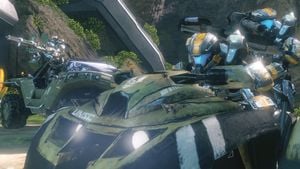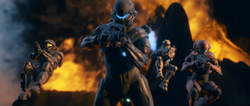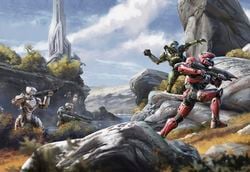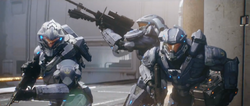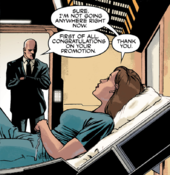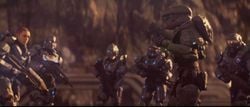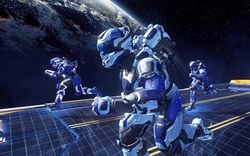Spartan Operations
From Halopedia, the Halo wiki
| Spartan Operations | |
|---|---|
 The logo of Spartan Operations | |
|
Formed: |
|
|
Affiliation: |
|
|
Branch: |
|
|
Type: |
Independent branch |
|
Role: |
|
|
Size: |
|
|
Engagements: |
|
|
Commanders: |
|
- "Spartans, like Navy, or Army, or Marines, are UNSC. Spartans are humanity's first line of defense, against threats from within and without. Spartans are what will see us through the darkness ahead and into the dawn beyond."
- — Commander Musa Ghanem, to a board of UNSC Navy officers[6]
Spartan Operations,[4][7] also referred to as the Spartan branch[8][9] or simply the Spartans,[10][11][12] is the fifth and newest branch of the United Nations Space Command's Armed Forces, organized under both UNSC Naval Command and the Unified Ground Command. The branch is responsible for the command of special operations undertaken by all Spartan-IVs, with many Spartan-IIIs integrated into their ranks. However, the surviving Spartan-IIs and select Spartan-IIIs remain in the UNSC Navy branch's Special Forces. Although Spartan Operations has autonomy from the other four branches of the Armed Forces,[13] the Spartans closely collaborate with the UNSC Navy and share assets with the Marine Corps and Army.[14] Additionally, they are excluded from FLEETCOM and Unified Ground Command under UNSC DIR 1100.D9 and 6899.01, respectively.[15]
The branch was established in 2553, shortly after the end of the apocalyptic Human-Covenant War, a time which saw a dramatic increase in the numbers of Spartan supersoldiers upon the activation of the SPARTAN-IV program.[10] The operations conducted by these Spartans are collectively referred to as the Spartan Ops program.[16]
Roles and operations[edit]
Spartan Operations was created to serve as the most elite infantry force used by the United Nations Space Command,[13] serving as a joint special operations branch that often undertakes missions involving unconventional warfare. The primary mission of the branch is to secure peace throughout human space using elite soldiers to quell threats and other hostile factors.[17] With the end of the Human-Covenant War, Spartan Operations played a large role in combating the hostile Covenant remnants to protect the colonies and citizens of the Unified Earth Government, while also aiding other allied factions, such as the Swords of Sanghelios.[18] In addition, the Spartan branch also combated insurrectionist factions with the continuing Insurrection, most notably the United Rebel Front and New Colonial Alliance.[19]
With the branch's activation in 2553, some of the UNSC's most prominent and effective personnel have been assigned to specialized combat and intelligence gathering teams, such as Fireteam Osiris. These teams are composed of highly proficient operators with varied skills to provide them with significant flexibility in carrying out their assigned missions. Such teams carry out challenging operations directly under the UNSC High Command and Security Council.[20]
History[edit]
Origins and conception[edit]
- "Realistically, the pervasiveness of the modern soldier will never be on the decline, at least not in our time. But ubiquity and numbers don't always guarantee operational success, something Naval Intelligence recognized long ago. Rather than drown out our enemies in an avalanche of bodies, we saw the value intrinsic in the specialization and refinement of a very select number of soldiers—a remarkably select number, actually. This is how the Spartan branch came to be."
- — Codename: SURGEON[21]
The production of large numbers of Spartan supersoldiers with relative ease did not become possible in practice for the United Nations Space Command until the end of the Human-Covenant War. Despite this, optimistic projections in 2531 suggested that one hundred thousand Spartans might be created in the following thirty years.[22] Between 2531 and 2552, nearly one thousand Spartans were trained, augmented, and graduated as part of the SPARTAN-III program, masterminded by Army veteran and Office of Naval Intelligence confidant Colonel James Ackerson.[23]
The SPARTAN-IV program entered development on September 20, 2552,[24] unknown to Ackerson.[13] The project was conceived by Commander Musa Ghanem, a former Spartan-II crippled by the augmentation process given an opportunity to relaunch the SPARTAN program. Despite believing that the methodology of the SPARTAN-II program was highly unethical, Musa was also adamant that the Spartans were critical for humanity's survival and would continue to be so in the following years.[1] Due to ethical factors, as well as advancements in technology now allowed the augmentation of adult subjects without the major risks which necessitated the use of children in the preceding programs, it was decided that future Spartans would be consenting adults, all of whom handpicked for their exceptional service during the war, mainly from special operations units from across the UNSC.[10][25] This marked a return to the recruitment methodology of the ORION Project, which had created bio-engineered soldiers to fight the growing Insurrection in the Outer Colonies over sixty years earlier. Coincidentally, the Spartan-IVs would come to serve in a similar capacity, fighting resurgent colonial rebellions.[13]
Admiral Margaret Parangosky, the Commander-in-Chief of the Office of Naval Intelligence who had previously authorized the second and third Spartan generations, approved of the new program, particularly because of its moral transparency in comparison to the previous iterations.[25] Originally Parangosky planned to give command of the SPARTAN-IV program, and ultimately the Spartan branch, to Colonel Ackerson. Serving under him, presumably in a scientific role to enhance the augmentation procedures and spearhead new technologies, would be Doctor Catherine Halsey, matriarch of the SPARTAN-II program.[26] However, neither would come to serve the project; Ackerson was executed as a prisoner of war aboard the Covenant battlecruiser Triumphant Declaration following his defeat on Mars in November 2552,[27] while Halsey became trapped within the Forerunner shield world Trevelyan and was later exiled to Ivanoff Station orbiting Installation 03 and then onboard UNSC Infinity by Parangosky.[28]
Formation and independence[edit]
- "As of today Spartans stand on their own. Not as Navy or ONI assets. We are our own branch. As of now."
- — Commander Musa Ghanem, to a council of high-ranked officers at HIGHCOM Facility Bravo-6[6]
On January 7, 2553, the first class of Spartan-IVs was selected, consisting of 145 candidates.[13] Spartan-III Jun-A266 was selected as the recruiter for the program, and Jun continued recruitment for the first class until February 15, 2553.[17][29] Although subsequent classes of Spartan-IVs were desirable, the initial class was required to prove itself effective.[17] The first class of Spartans began training at several War Games sites, particularly aboard UNSC Infinity.[13] In January of 2553, five Spartan-IVs of the program's first class were aboard UNSC Infinity when Admiral Mattius Drake's New Colonial Alliance boarded the ship in the Sol system's Oort cloud and briefly commandeered the warship; the hijacking was led by the Ilsa Zane, a turncoat soldier who was rendered unstable due to experimental Spartan-IV augmentations. The Spartans' repelling of the takeover attempt also exposed Admiral Drake as a traitor. Following the incident, Musa Ghanem announced the establishment of the Spartans as their own distinct branch to a board of UNSC Navy officers at HIGHCOM Facility Bravo-6 in Sydney.[6]
With the creation of the branch, most of the surviving Spartan-III supersoldiers were requested by Admiral Parangosky and Naval Intelligence for reassignment to Spartan Operations in early 2553. The active Spartan-IIs were given the choice of "pulling together" the remaining Spartan-IIIs and integrating them into the SPARTAN-IV program.[30] At least Spartan-II Blue Team continued to operate outside the branch, within Naval Special Warfare Command operational control, as of most recent knowledge. Their operations remained highly secretive.[31] On January 3, 2554, after the critical success of the first class, a second class of Spartan-IVs was created for the branch and Jun launched a new recruiting drive. With increased funding, Spartan Operations was able to include a larger amount of candidates, though continued to ensure that all were of high quality with strong loyalties to the UEG and UNSC.[32] However, Rudolf Schein of the United Rebel Front managed to infiltrate the branch and attempted to destroy the space station hosting the entire second class, as well as several members of the branch's leadership and administrative staff. However, this attempt was foiled by Jun and Musa. The incident was kept a secret, with Musa fearing that the event would compromise the Spartan branch's independence.[19]
Combat deployments[edit]
Since its instatement in early 2553, the Spartan branch has seen a number of engagements in both the resurgent Insurrection and the continuing hostilities against rogue Covenant factions. Sometime during 2554, two of the first Spartan-IVs, Edward Davis and Sarah Palmer, were present in a battle against Merg Vol's Covenant on the former Forerunner world and UNSC research colony of Draetheus V.Template:Ref/game Spartans participated in numerous other conflicts, such as the rebellion on Draco III or the numerous revolts on Talitsa, both launched by the URF.[33][34]
During an exploration mission in July 2557, UNSC Infinity was pulled into Requiem, an ancient Forerunner shield world, by a Cryptum-occupying Promethean known as the Didact and his forces. Led by Commander Palmer, the Spartans, aided by Infinity's Marines, would assist MCPO John-117 in his fight against the Prometheans, as well as the distracting Jul 'Mdama's Covenant which had followed the beleaguered Spartan-II to Requiem.[35] The Spartans teamed with John-117 to destroy the gravity well generator and to defend Infinity from attacks by the Didact, but left with Infinity when Captain Andrew Del Rio chose not to stay and stop the Didact, an order John-117 disregarded.[36] In February 2558, eight months after John-117 defeated the Didact and saved Earth, Infinity returned to Requiem and deployed forces from all five branches of the United Nations Space Command armed forces, including numerous Spartan fireteams. On Requiem, fighting both Covenant forces and the Prometheans, the UNSC sought to capture the shield world. Despite the efforts of numerous Spartans, the Covenant destroyed Requiem after retrieving half of the Janus Key, while the UNSC held the other half.[37]
Organization[edit]
- "Word was that Musa had used the incredible success of the first class of Spartan-IVs to divorce the program from the Navy and, more specifically, Naval Intelligence. While the SPARTAN program worked in concert with both of those groups—and recruited heavily from them—the Spartans became their own branch of the UNSC's military. That gave them a lot more leeway with their missions, and it meant they weren't under anyone's thumb."
- — Spartan Edward Buck[38]
Spartan Operations is an independent, and the most recently established, branch of the United Nations Space Command's Armed Forces. As is the state of the UNSC Marine Corps, the Spartan branch is organized under both the Unified Ground Command and UNSC Naval Command, specifically Fleet Command.[15] Although originally under the jurisdiction of the UNSC Navy, particularly the Office of Naval Intelligence, Spartan quickly evolved into an organization of its own,[21] until then-Commander Musa Ghanem went before a board of naval officers and proposed the branch's autonomy.[6] The success of the first class of Spartan-IVs led to UNSC leadership accepting Musa's proposal. The branch's independence offers them more freedom with its operations.[38] Spartan Operations, while technically autonomous, maintains close relationships and often works in collaboration with the Navy and other branches when needed, most often in administrative capacities.[13] Because of this and the SPARTAN programs' history, the Spartans are still commonly viewed as a "Navy project" by the UNSC armed forces at large.[39] ONI has the ability to requisition the service of Spartan personnel for specific, high-importance operations.[40] For example, when Spartan-II Blue Team became absent-without-leave, Spartan Fireteam Osiris was placed under the Navy's Naval Logistical Operations Command operational command when deployed to retrieve the Spartan-IIs.[4] The branch is headed by the Chief of Staff of Spartan Operations; the office is currently held by Jun-A266.[5] As of 2558, Spartan Operations does not hold a seat on the UNSC Security Council, unlike the other four branches of the Armed Forces and even ONI.[41] The branch also maintains the Spartan Training and Education department.[15]
Spartan personnel are typically organized into fireteams, consisting of five or four Spartans, led by a Spartan designated as team leader.[13] Most Spartan combat units are composed of personnel which would complement each other's skillsets and abilities, mitigating any individual deficiencies.[20] Some Spartans operate in smaller or even individual units. All detachments of Spartans operate under a Spartan Commander.[13] Although most Spartan-IVs are attached to the Spartan branch, several still serve directly under the Office of Naval Intelligence's divisions, such as the Delta-6 Division[34] or the Asymmetrical Action Group.[42] The Spartan branch has a dedicated facility on Mars, where personnel undergo their augmentations.[43]
Spartan Operations retains the Spartan-IIIs' Headhunters program, though it has since undergone various changes and adjustments to its structure. The program now consists of a select list of Spartan-III and Spartan-IV operatives that are deployed in either single or two-person teams.[44]
Personnel[edit]
- "We hailed from all walks of the UEG. Human men and women of all races, from colonies of all sizes. The only things we had in common were our total commitment to the UNSC—and our humanity."
- — Spartan Edward Buck, on the personnel recruited by the branch[45]
Personnel of Spartan Operations are biologically and cybernetically enhanced, heavily armored human supersoldiers.[13] The Spartan branch recruits adult men and women from across all of Unified Earth Government's colonies.[45] A majority of the Spartan branch's personnel are Spartan-IVs, though several Spartan-III personnel have also joined the branch,[13] excluding those of Gamma Company who were reassigned to the Office of Naval Intelligence on Admiral Margaret Parangosky's orders.[46] A handful of Spartans serve in the branch in administrative roles; these include the branch's creator Musa-096;[6] Jun-A266, former sniper of NOBLE Team;[47] and the two Beta Company survivors, Tom-B292 and Lucy-B091, who served as instructors for Spartan-IV recruits between 2553 and 2554.[48] Some Spartans, such as Jared Miller, also serve as mission handlers for Spartan detachments.[49]
Spartan-IVs of the branch undergo augmentation procedures involving gene therapies, artificial organ implants, and cybernetic enhancements. Each augmentation is custom-tailored to each individual Spartan.[43] Most of these augmentations are irreversible, and only a handful of personnel within the UEG and UNSC have truly considered the future impact these men and women will have when they leave military service and re-enter civilian life. There also exists developing concerns relating to the possibility of potentially unstable, partially augmented retired Spartans that lack the training and support available to former Spartan personnel.[50]
During the Human-Covenant War, Spartan fatalities were always listed as missing in action or wounded in action in accordance with ONI Directive 930 in order to bolster morale by maintaining a myth of invincibility around the almost legendary supersoldiers. This practice was not carried over to the Spartan branch following the Covenant War, allowing the deaths of Spartans to be formally acknowledged.[51]
Selection and recruitment[edit]
- "I'm a good judge of character, Buck. Add in the fact that I have a cutting-edge AI on my side, and it's rare that I make a mistake about someone."
- — Spartan Jun-A266 to Edward Buck, commenting on his selection process[52]
Individuals are recruited into the branch based on their achievements and skills as soldiers in other branches of service.[40] Spartan candidate recommendations are made from commanding officers directly to recruiter Jun-A266.[7] Each candidate for the Spartan branch is heavily screened, both career military veterans and younger soldiers who demonstrate promising careers. After passing a rigorous series of tests, the candidate is given the non-compulsory option of enlisting in the branch and undergoing Spartan-IV augmentations.[21] Each recommended candidate is meticulously examined by Jun and Musa with the aid of a dedicated, cutting-edge artificial intelligence,[52] as well as a thorough background check and a physiological evaluation. The candidate's communications records and past associations are also examined.[43]
Despite these efforts, Rudolf Schein of the United Rebel Front was still able to infiltrate the branch and become successfully augmented as a Spartan-IV, having prior led a successful career within another branch of the United Nations Space Command armed forces.[19] Schein was later partially responsible for Spartan Michael Crespo's defection to the URF, with both Spartans growing disillusioned with the UEG and UNSC after being deployed to combat human insurrectionist forces, having originally enlisted with the UNSC to combat the alien Covenant.[53] Likewise, Spartan Vladimir Scruggs was recruited as a member of the first class of Spartan-IVs, but later became disillusioned with the UNSC's ideals and joined the New Colonial Alliance to sabotage peace talks between the Swords of Sanghelios and Lydus' clan on Ealen IV.[51] After these incidents, Musa and Jun decided to review their recruitment procedures to look for mistakes, but did not expect to find anything.[53]
However, pure combat proficiency is not the only requirement for admission into the Spartans. Olympia Vale was recruited into the branch, despite having minimal field experience. This is due to stellar combat scores in training exercises and her great diplomatic skills, as well as high recommendations from ONI.[8] Additionally, Anthony Madsen, who had previously served an undistinguished career in the UNSC Marine Corps, was admitted into the branch because of the recommendations of his father and grandfather, both generals in the Marines.[54]
UNSC Armed Forces retirees can also be enlisted in Spartan Operations under a recommendation regardless of how long they have been retired. Taylor Miles and Gretchen Ketola, both former ODSTs who were retired for years, re-enlisted as Spartans.[citation needed]
On a rare occasion, a whole squad can be recruited as a Spartan. Alpha-Nine is one of the examples where Jun recruits Buck and his entire teams after the Draco III rebellion. This allows Alpha-Nine to retain its identity as a Spartan Fireteam without using standard fireteam names commonly used on Spartan Operations upon the Squad's re-establishment after the events on Cassidy III.[citation needed]
Rank structure[edit]
- "You are Spartans now. You stand side by side with your Spartan brothers and sisters. You march into battle together—you do not charge ahead. You do not grab glory for yourself. Spartans don't have ranks because Spartan is your rank."
- — Commander Musa Ghanem, addressing Spartan-IV trainees[55]
Unlike the other four branches of the UNSC, which maintain hierarchical rank structures, all personnel of Spartan Operations are considered equal and lack formal ranks,[13] a view especially emphasized by Rear Admiral Musa Ghanem. However, some personnel within the branch wield far more authority than others, with Musa himself a rear admiral and considered the Commander in Chief of the Spartans (CINCSPAR).[56] The standard Spartan rank held by all members of the branch is equivalent in authority to a First Lieutenant in other parts of the UNSC; Spartans holding the role Fireteam leader are equivalent in authority to a Captain and lead four or five other Spartans. Spartan mission handlers hold an equivalent authority to a Major and serve as managers for between five and ten fireteams (20-50 Spartans), while a Spartan Commander is responsible for oversight of all Spartans in a given company - typically measuring around three hundred (or more) personnel.[57]
| Role | Spartan | Fireteam Leader | Mission Handler | Spartan Commander | Director of Spartan Operations |
| Responsibilities | Augmented special forces equipped with MJOLNIR Powered Assault Armor. | Field leader of a fireteam of 4-5 Spartans. | Spartan Command liaison and intelligence support stationed at headquarters. Responsible for managing 5-10 fireteams, or 20-50 Spartans. | Overall command-and-control of Spartan Company. Responsible for upwards of 300 Spartans. | Commander-in-Chief of the Spartans (CINCSPAR) |
| UNSC authority | First Lieutenant | Captain | Major | Colonel | General |
With no formal rank structure, each Spartan of the branch is given the informal rank of "Spartan". Each Spartan detachment is under the authority of a Spartan Commander;[13] for example, Edward Buck formerly served as Spartan Commander of the detachment aboard UNSC Meriwether Lewis,[4] while Sarah Palmer continues to serve as Spartan Commander of the Spartans of UNSC Infinity.[58] Despite being the ranking Spartan on the ship, Palmer deferred to the Master Chief while he was aboard during the Battle of Requiem with the Master Chief effectively acting as the ranking Spartan during this time.[59]
Standing and specialization within the Spartan branch is also determined by the personal skill of the individual alone, demonstrated both in combat in the field and in training exercises.[13] Spartans can apply to become Specialists, proving their abilities in a specific field above-and-beyond the already-high standards of a regular Spartan. Spartans who achieve their Specialist rating are granted access to more specialised and experimental weapons, armour, modifications and equipment which most Spartan personnel are not granted access to. Multiple Specialist ratings can be applied for, and granted.[39]
This skill is reflected by "Spartan Rank", which has an alphanumeric value between SR1 and SR130 - something Spartans are able to achieve by training in War Games simulations. Spartans who meet or exceed SR50 are allowed to apply for multiple specialist ratings.[39]
Training[edit]
- "You are Spartans when you graduate this program. And you graduate this program when I say so. Do you know what that means? It means you're not a goddamn Spartan until I say you're a goddamn Spartan! You might feel like a superhero, but right now you're as useless as a baby—and the UNSC doesn't need any goddamn babies!"
- — Captain O'Day, to complaining Spartan-IV trainees[60]
Directly after augmentations, Spartan personnel immediately begin their training.[43] One of the training facilities used by the branch was a secret, dedicated space station orbiting an otherwise unimportant dwarf planet. In training, an important emphasis is placed on breaking the bad habits the older or more experienced personnel may have built over the years of their service, as well as giving the Spartans practice with their newly acquired augmentations.[61] The training also serves to teach the Spartans to work together among each other as equals.[55] The Spartans are trained by drill instructors hand-picked by ONI. Captain O'Day was the drill instructor that trained the second class of Spartans. As part of the training, the Spartans compete in War Games simulations and are pitted against automated weaponry—that utilize non-lethal, yet still painful, ammunition—guided by the UNSC's sharpest combat veterans.[61] All Spartans receive training on how to use jetpacks in-atmosphere.[62] Spartans of the first class also faced off against UNSC Marines armed with weapons using stun rounds, in which the Spartans had to navigate and complete an obstacle course.[55] After the Spartans completed training, they were then allowed to select their armor.[61] The training of the Spartans is overseen by the branch's Spartan Training and Education department.[15]
After the initial training, Spartans are expected to continue practicing and remain combat-ready by participating in War Games, competitive combat training simulations that utilize holography and millions of pneumatic risers.[63] Wars Games allows Spartans to compete among each other in various gamemodes and simulations based off of numerous locations or events, thus allowing the Spartans to train and prepare for similar situations. UNSC Infinity hosts a massive War Games combat deck for the Spartans, as do other modern warships. Space stations—such as Anvil Station and the Munera Platforms—and terrestrial military bases are also home to War Games facilities.[64]
Several Spartan-IIs have also assisted with the training of the personnel of the Spartan branch.[13] The ANVIL initiative indicates a number of very select joint training engagements between Spartans of the branch and Sangheili of Arbiter Thel 'Vadam's Swords of Sanghelios aboard Anvil Station.[44]
Equipment[edit]
Spartans of the branch are equipped with the second generation of the MJOLNIR Powered Assault Armor. GEN2 Mjolnir integrates the vast majority of the armor's vital hardware systems within the inner techsuit itself, allowing for more streamlined production and easier implementation of specialized subsystems and armatures. The armor is built to incorporate many attachments, such as jetpacks and active camouflage.[65] As the Spartan-IVs have less extensive biological augmentations, the GEN2 armor boosts its operator's reactions, speed, and strength to a greater degree than the first-generation Mjolnir.[66] Spartans are occasionally entrusted and deployed with advanced Office of Naval Intelligence technology, such as the Artemis Tracking System.[67]
Spartans do not have their own armored vehicles, aerospace craft, or slipspace-capable transports; they rely on the UNSC Navy for interstellar deployment and have arrangements with the Marine Corps and Army to loan their assets when necessary.[14] However, several weapons have been specifically designed for use within Spartan Operations and are rarely seen outside the branch, such as Chalybs Defense Solutions' MLRS-1 Hydra.[68] The M395 DMR was also manufactured specifically for use within the Spartan branch, though the rifle has also seen use among other UNSC branches.[69]
Production notes[edit]
- The role of the Spartan Operations branch is similar to that of the United States' Joint Special Operations Command (which is a sub-unified command, but not an independent military branch). It consists of the U.S. Armed Forces' most highly trained special operators, including such units as the U.S. Army's Delta Force, the U.S. Navy's SEAL Team Six, and U.S. Air Force's 24th Special Tactics Squadron.
- As depicted in Issue #7 of Halo: Escalation, the dress uniform for the Spartan branch is nearly identical to the service uniform used by the cadets at Corbulo Academy of Military Science, only colored navy blue and black as opposed to the white and black coloration of the Corbulo uniforms. The uniforms seen in Escalation even incorporate the single lozenge used to identify freshman cadets at Corbulo; it is uncertain whether this holds any particular significance regarding the Spartans' rank or if it is simply a mistake.
List of appearances[edit]
Sources[edit]
- ^ a b Halo: Initiation, issue 1
- ^ a b Halo Waypoint - Universe - Factions, UNSC (Retrieved on Sep 12, 2015) [archive]
- ^ Halo 4: The Essential Visual Guide, page 33
- ^ a b c d Halo 5: Guardians, Limited Edition: Spartan Locke's Classified Orders
- ^ a b Halo Waypoint, Memories of Reach (Retrieved on Jun 17, 2016) [archive]
- ^ a b c d e Halo: Initiation, issue 3
- ^ a b Halo: Escalation, issue 18: "…to Mr. Jun, Spartan Operations."
- ^ a b Halo Waypoint - Universe - Characters, Olympia Vale (Retrieved on Sep 15, 2015) [archive]
- ^ Halo 4, Limited Edition: Spartan armor customization schematic
- ^ a b c Halo Waypoint, Spartan-IV (Retrieved on Mar 19, 2012) [archive]
- ^ Halo 4 - Spartan Ops, episode Departure: "Navy disagrees with Spartans on this one." - Thomas Lasky
- ^ Halo 4 - Spartan Ops, episode Didact's Hand: "I enlisted with the Spartans because…" - Gabriel Thorne
- ^ a b c d e f g h i j k l m n o Halo Waypoint - Universe - Factions, Spartans (Retrieved on Oct 27, 2015) [archive]
- ^ a b Halo Waypoint, Canon Fodder - Reqlamation Begins (Retrieved on Dec 23, 2019) [archive]
- ^ a b c d Halo Legendary Crate - Data Drop #1
- ^ Halo Waypoint, Halo: Spartan Strike: "…the historic first missions of the Spartan Ops program…" (Retrieved on Oct 29, 2015) [archive]
- ^ a b c Halo: New Blood, pages 50-55 (Google Play edition)
- ^ Halo: New Blood, pages 146-148 (Google Play edition)
- ^ a b c Halo: New Blood, pages 139-144 (Google Play edition)
- ^ a b Halo Waypoint - Universe - Factions, Fireteam Osiris (Retrieved on Nov 24, 2015) [archive]
- ^ a b c Eleventh Hour reports, 3 - THE NEW SOLDIER
- ^ Halo: Ghosts of Onyx, page 64
- ^ Halo: Ghosts of Onyx, page 43
- ^ Halo: Glasslands, page 422
- ^ a b Halo: Glasslands, page 434
- ^ Halo: Glasslands, page 147
- ^ Halo: Uprising, issue 1
- ^ Halo: Glasslands, page 341
- ^ X.com, Jessica Shea (@bsangel): "#TodayInHalo 2/15/2553 E. Buck and V. Dare go on shore leave after the war. Buck is approached by Jun-A266 for integration into SPARTAN-IV." (Retrieved on Feb 15, 2016) [archive]
- ^ Halo: Glasslands, page 435
- ^ Halo Waypoint Forums, John-117 is no longer blue leader (Retrieved on Dec 29, 2019) [local archive] [external archive]
- ^ Halo: New Blood, pages 105-107 (Google Play edition)
- ^ Halo: New Blood, pages 22-24 (Google Play edition)
- ^ a b Halo 4: The Essential Visual Guide, page 171
- ^ Halo 4, campaign level Infinity
- ^ Halo 4, campaign level Shutdown
- ^ Halo 4 - Spartan Ops
- ^ a b Halo: New Blood, page 130 (Google Play edition)
- ^ a b c Halo 4, Limited Edition: Infinity Briefing Packet
- ^ a b Halo: Hunters in the Dark, pages 78-79
- ^ Halo: Escalation, issue 1
- ^ Halo 5: Guardians, Armor Hall: Legendary visor description "The Beta-5 Asymmetrical Action Group has adopted the Legendary VISR for their Spartan units, albeit with custom plugins developed by ONI's internal teams."
- ^ a b c d Halo: New Blood, pages 113-120 (Google Play edition)
- ^ a b Halo Waypoint, Canon Fodder - Have S'moa (Retrieved on Mar 28, 2019) [archive]
- ^ a b Halo: New Blood, page 115 (Google Play edition)
- ^ Halo: Last Light, pages 330-331 (Google Play edition)
- ^ Halo Waypoint Forums, Catalog Interaction: "[frumentarii] records indicate queried individual maintains a [command and control] role in Human [exploratii] security forces." (Retrieved on Apr 13, 2016) [local archive] [external archive]
- ^ Halo: Fractures - Lessons Learned
- ^ Halo 4 - Spartan Ops, episode Departure, level Land Grab
- ^ Halo Waypoint, Canon Fodder - Armory Armore (Retrieved on Oct 24, 2016) [archive]
- ^ a b Halo: Escalation, issue 3
- ^ a b Halo: New Blood, page 106 (Google Play edition)
- ^ a b Halo: New Blood, pages 177-179 (Google Play edition)
- ^ Halo 4: The Essential Visual Guide, page 23
- ^ a b c Halo: Initiation, issue 2
- ^ Halo: New Blood, pages 7-8 (Google Play edition)
- ^ Halo: Official Spartan Field Manual - Part 2: The Spartan Program, Spartan Command Structure, page 32-33
- ^ Halo Waypoint - Universe - Characters, Sarah Palmer (Retrieved on Nov 24, 2015) [archive]
- ^ Halo 4
- ^ Halo: New Blood, page 125 (Google Play edition)
- ^ a b c Halo: New Blood, pages 122-126 (Google Play edition)
- ^ Halo Waypoint - Universe - Tech, UNSC Jet Pack (Retrieved on Oct 27, 2015) [local archive] [external archive]
- ^ Halo 4 Field Guide, page 22
- ^ Halo Waypoint, Canon Fodder - Needle Me This (Retrieved on Jul 16, 2019) [archive]
- ^ Halo Waypoint - Universe - Tech, MJOLNIR (Retrieved on Nov 27, 2015) [local archive] [external archive]
- ^ Frank O'Connor interview during San Diego Comic-Con 2012 (1:15–2:10)
- ^ Halo Waypoint - Universe - Tech, Atremis Tracking Software (Retrieved on Sep 19, 2015) [local archive] [external archive]
- ^ Halo Waypoint - Universe - Weapons, Hydra Launcher (Retrieved on Nov 24, 2015) [archive]
- ^ Halo Waypoint - Universe - Weapons, DMR (Retrieved on Nov 24, 2015) [archive]
